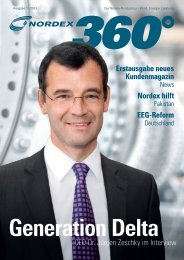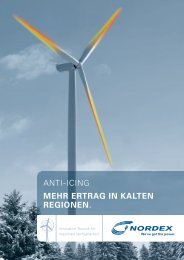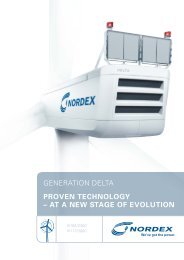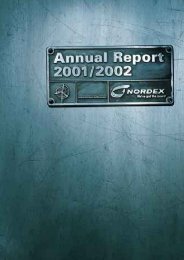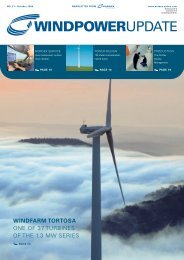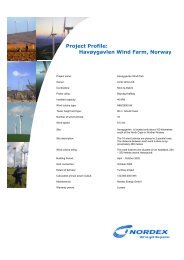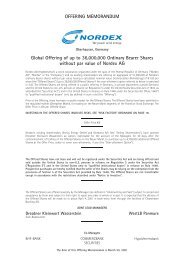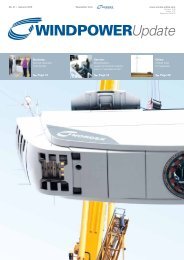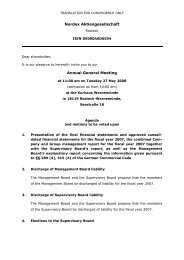Download WindpowerUpdate 15 - Nordex
Download WindpowerUpdate 15 - Nordex
Download WindpowerUpdate 15 - Nordex
You also want an ePaper? Increase the reach of your titles
YUMPU automatically turns print PDFs into web optimized ePapers that Google loves.
phoria to Reality<br />
For some time now, one concept has been electrifying the<br />
wind energy sector: everyone is talking about “offshore”.<br />
Hardly a day goes by without yet more apparently major contributions<br />
being added to the public debate on the use of our<br />
oceans. But only some 100 MW of capacity are currently installed<br />
off the coasts of Europe. This represents approx. 0.4 % of<br />
installed wind power capacity worldwide. And in Germany?<br />
Nothing doing. To date, the precautionary principle has prevented<br />
even the smallest steps offshore. So where does the<br />
euphoria come from?<br />
Experts from the Danish consulting company BTM-Consult<br />
estimate the wind energy potential for the European seas at up<br />
to 125,000 MW. They reckon that German coastal areas alone<br />
could provide 20,000 MW. Huge against the backdrop of the present<br />
25,000 MW of installed capacity – worldwide! According<br />
to Greenpeace expertise, if the German offshore potential is<br />
optimally used, a good half of the electricity consumption in<br />
Germany can be covered alone by wind power generated at<br />
sea. Yet, according to estimates by the German Wind Energy<br />
Institute, the offshore market will not take off until the second<br />
half of this decade. Then finally in Germany too. Just in time to<br />
compensate for the lack of space onshore. German wind energy<br />
companies which, unlike <strong>Nordex</strong>, are not involved in foreign<br />
markets have to trust this forecast.<br />
Nevertheless, the advantages of offshore operation are<br />
obvious: thanks to the strong and more constant winds at sea,<br />
higher yields can be obtained than onshore. At the same time,<br />
the machines are subjected to lower strains as a result of reduced<br />
turbulence. The consequence: reduced wear on the turbine.<br />
The real challenges are technical in nature. Adapting the<br />
machine to offshore conditions does not present a major<br />
problem: the electrotechnical units are moved from the foot to<br />
the head of the unit and the machine house protected against<br />
the saline atmosphere by means of a dehumidifier. The additional<br />
costs involved are quire reasonable. However, the situation<br />
is different for the foundation and for installation. This is<br />
where the main cost blocks are involved which make an<br />
offshore project up to 50 % more expensive than wind parks<br />
onshore. Gravity foundations are used today for projects realised<br />
in shallow coastal waters. But the future lies 30 to 40 kilometres<br />
offshore, at water depths of down to 40 metres. Here<br />
different methods have to be used, such as the monopile or tri-<br />
The market for wind turbines will grow by approx.<br />
20 % per annum in the coming years. Especially in<br />
Spain, the USA, France and Great Britain. The German<br />
market too will continue at a high level in the next few<br />
years.<br />
However, another topic also has to be considered:<br />
offshore application. By the year 2006, wind parks with<br />
a capacity of several thousand MW could be created in<br />
European coastal waters alone.<br />
pod – much more expensive foundations. So the aim pursued<br />
by manufacturers of wind turbines is clear: installation of the<br />
maximum possible yield potential on each foundation. This<br />
is why <strong>Nordex</strong> is developing a new, large turbine in the<br />
5-MW class. The objective is to make the costs per kW specific<br />
to offshore operation both calculable and economical.<br />
In addition to this, the installation concepts at sea are based on<br />
platforms and ships with lifting devices which independently<br />
raise themselves above the surface of the water, thereby offering<br />
a stable working platform. These too are unsuitable for transport<br />
in heavy seas and cannot work continuously. This means<br />
that the actual process of erection must be made faster and so<br />
more cost-favorable.<br />
In Germany, it is high time for the first pilot projects to be<br />
realised if a breakthrough is to be made in the offshore market.<br />
These will enable manufacturers and partner companies to gain<br />
initial experience with offshore units. It is not only the wind<br />
energy sector and the shipyard industry that will benefit. 6 million<br />
tons of steel are needed to build the units solely to exploit<br />
the German offshore potential of 20 gigawatts. This is approximately<br />
equivalent to the quantity of sheet steel produced annually<br />
throughout Europe.<br />
No. <strong>15</strong> ı December 2002 13



